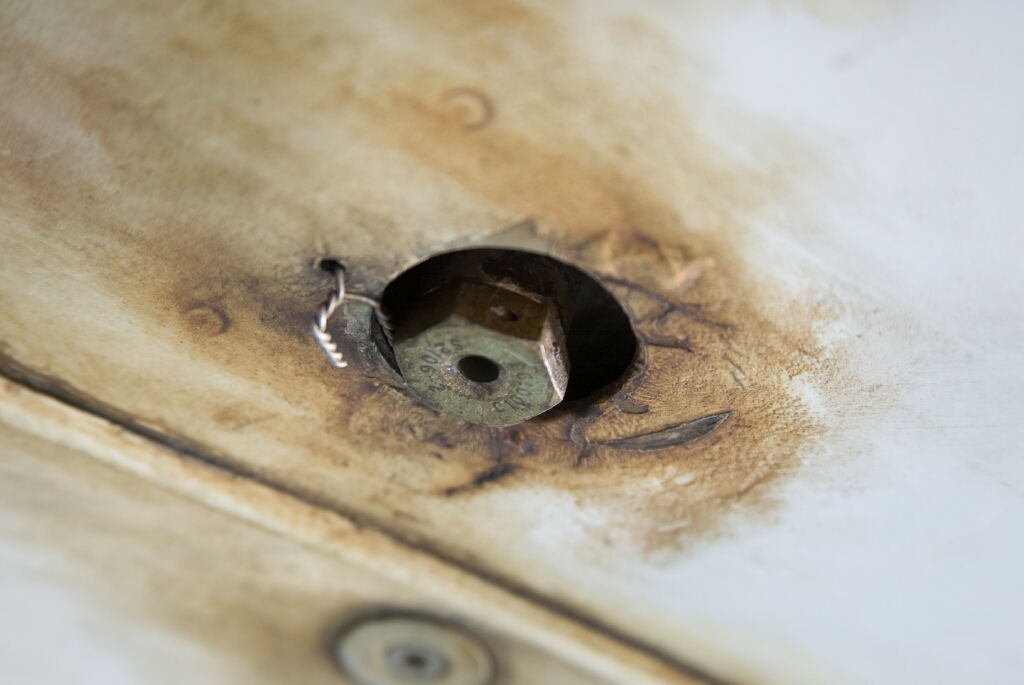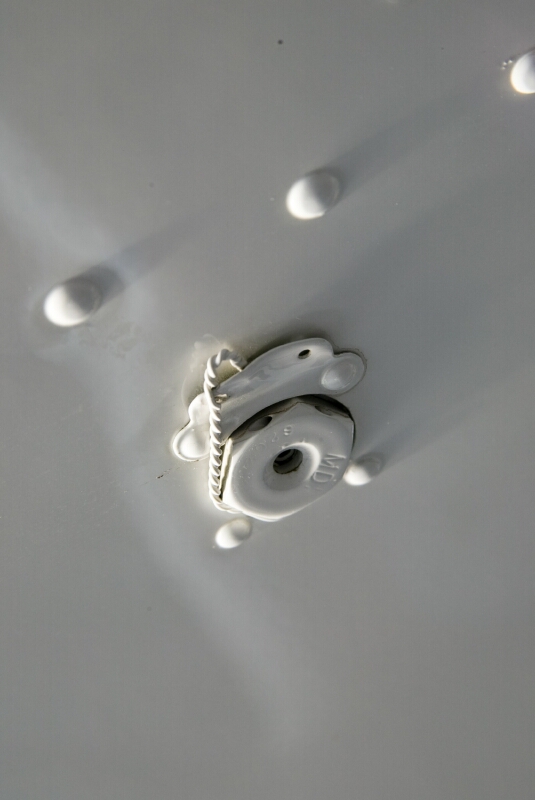Aircraft Corrosion

Importance to Members
An aircraft, like any metal object, is inherently prone to corrosion. There is a lot of time spent painting an aircraft to help delay corrosion, but inevitably, nature will prevail. Usually the development of corrosion will depend on how old the aircraft is, what type of environment it is based in, whether or not it is hangared, and how often it is cleaned. This subject report discusses the different types of corrosion, and how to recognize them.
Please call AOPA’s Pilot Information Center with questions – 800-USA-AOPA (872-2672) Monday through Friday, 8:30 to 6:00 ET.
Overview
Corrosion on aircraft is nothing more than rust of the metal parts, although aluminum corrosion doesn’t produce the reddish color most people think of as rust. Rather, it usually first shows as a whitish or gray “dulling” of the aluminum surface, then progresses to more and more severe pitting and eventual destruction of the metal. Left untreated, corrosion can make an aircraft unairworthy in just a few years.
Technical Information
Types of corrosion normally found on aircraft include:
-
 Uniform surface attack. This is the most common type and is caused simply by exposing the metal to oxygen in the air, such as when paint is worn off wing skin or the fuselage. Poor pre-paint preparation at the factory, fumes, acid, pollutants, or high humidity accelerate the decay.
Uniform surface attack. This is the most common type and is caused simply by exposing the metal to oxygen in the air, such as when paint is worn off wing skin or the fuselage. Poor pre-paint preparation at the factory, fumes, acid, pollutants, or high humidity accelerate the decay. - Intergranular corrosion. Normally worst on 7000-series alloys (those with an appreciable amount of zinc, like wing spars, stringers and other high-strength aircraft parts), this is not frequently found but is a particularly nasty type of corrosion. It can be difficult to detect, and once you see it, it’s too late: that piece of metal is toast.
- Stress corrosion. In highly stressed parts like landing gear or engine crankshafts, this type may develop from a scratch or surface corrosion. Crankshaft failures are often due to undetected corrosion of this type.
- Crevice or deposit corrosion. This can occur anywhere there is an area where moisture or other pollutants are trapped. Lapped skin joints or rivets on an oil-stained belly are examples of prime corrosion spots.
- Filiform corrosion. Particularly on aluminum surfaces poorly prepared for polyurethane paints, this type of corrosion will show up as fine, worm-like lines of corrosion under the paint that will eventually lead to bubbling and flaking.
Any metal aircraft is a candidate for corrosion, but thousands of single-engine Cessna’s built from 1977 through 1982 seem to be particularly susceptible to the worm-like filiform corrosion that starts under the paint. According to Aviation Consumer magazine, Cessna’s problems started when the company switched to the then-new polyurethane paints for aircraft built in its Pawnee, Kansas, assembly plant. Although the paint was considered superior to old-fashioned enamels and lacquers, Cessna apparently did not follow the paint manufacturer’s recommendations for more extensive preparation of the aluminum surface. A special program to help owners with repainting (called SP79-3S) was set up by Cessna but not widely publicized.
As the general aviation fleet ages, corrosion is becoming an increasingly common problem. Since moisture is a culprit for most common types of corrosion, aircraft based in coastal areas are often in particular danger. Many potential aircraft buyers will shy away from a bird that has spent much time in Florida, along the Gulf Coast or in Pacific Coast areas of the west. Said one aircraft appraiser, “there’s just too much chance that such airplanes are rust buckets.”
Recently repainted aircraft offered for sale from such areas are regarded with particular suspicion by knowledgeable buyers because the paint could be covering up serious corrosion.
Hangaring, frequent washing, and regular treatment with rust inhibitors, such as ACF-50 (Aircraft Corrosion Formula 50), can help dramatically in slowing the deterioration of aircraft from corrosion.
A very thorough visual inspection will reveal most corrosion, and Advisory Circular 43-4A describes corrosion inspections and control for aircraft in great detail. Look for grayish-white powder on aluminum and reddish deposits on ferrous metals. Bumps or blisters in paint signify corrosion occurring under the surface, especially the filiform type common on aluminum that has been poorly prepared for painting. Filiform corrosion looks a little like cottage cheese under the paint.
Pay close attention to the trailing edges of control surfaces where the skins come together. Also, the inside of wheel wells on retractable models is a prime location for corrosion, not surprising considering its exposure to acids, salts, gravel, and other corrosion-producing substances. Use of a magnifying glass may reveal beginnings of corrosion not visible to the naked eye.
Checking for damage inside the aircraft is more difficult but necessary. Remove all inspection plates, and spend some time with a mechanic’s mirror (a mirror mounted on a stick) and a good strong flashlight. You’re looking for gray or whitish deposits on aluminum and the trademark rust on steel.
Areas of airplanes often damaged by corrosion include the propeller, cylinder fins, areas around fuel tanks or bladders, piano-type control hinges, and the battery box. Propeller corrosion occurs in two basic areas: on the surface of the blade, which is constantly abraded and exposed to the elements, and the hub of constant-speed propellers.
Corrosion is Mother Nature’s way to bringing your airplane back to its natural state, and there’s no reversing Mother Nature. Preventing corrosion is much easier than treating it, and one of the best ways is to base the airplane in a dry part of the country, as the Air Force does when it mothballs aircraft in the Arizona desert near Tucson. Other steps include protecting the aircraft in a hangar, washing it often to remove pollutants and dirt, and treating it with ACF-50 or other corrosion inhibitors. If you don’t have a hangar, make use of cabin covers, and ensure that all windows seal tightly to prevent moisture from attacking the fuselage from the inside out.
Removing corrosion is the only sure fix once it’s found. Light surface corrosion can be removed with abrasion (the specifics of which depend on the metallurgy of the corroded part), then application of a corrosion inhibitor, such as zinc-chromate primer, another primer, and then paint. Be careful when removing the corrosion with common steel brushes or stainless brushes that have been used on steel or rust; they will work steel into the aluminum, where it will ruin the paint job. If corrosion is severe enough to have removed a significant amount of metal, replacement of the part is usually the only solution. One corrosion inhibitor commonly used is ACF-50, manufactured by Lear Chemical Research Corporation in Mississauga, Ontario, Canada. It is a thin film compound formulated to penetrate corrosion deposits to the base of the corrosion cell, where it emulsifies and encapsulates the electrolyte, lifting it away from the metal surface. It penetrates seams, lap joints, cracks, and rivet heads and is normally applied at annual inspection time. Another product, called Boeshield T-9, is made of 13 solvents and oils, along with a wax that remains as a barrier film after the other components have evaporated. It is manufactured by PMS Products, Inc., in Holland, Michigan, and has an initially thin viscosity that is intended to allow it reach into assembled components, dissolve minor corrosion, displace moisture, and leave a coating. Both products come in cans and are sprayed under pressure.
Companies making corrosion inhibitors:
- Corrosion Technologies Corp., P.O. Box 551625, Dallas TX 75355-1625. Phone: 800-638-7361. FAX: 972-278-9721. Product is Corrosion-X.
- Lear Chemical Research Corporation, P.O. Box 1040, Station B, Mississauga, Ontario, L4Y 3W3, Canada. Phone: 905-564-0018. Fax: 905-564-7077. Product is ACF-50.
- LPS Laboratories, Inc., 4647 Hugh Howell Rd., Tucker GA 30084. Phone: 800-241-8334. Fax: 770-243-8899. Product is a line of LPS corrosion inhibitors.
- Chemetall Americas, 675 Central Avenue, New Providence, NJ 07974. Phone: 800-526-4473. Fax: 908-464-4658. Manufactures a line of corrosion inhibitors.
- PMS Products, Inc., 76 Veterans Dr. #110, Holland, MI 49423, Phone: 800-962-1732, Fax: 616-355-6675. Product is Boeshield T-9.
- Zip-Chem Products, 400 Jarvis Drive, Morgan Hill, CA 95037. Phone: 408-782-2335. Fax: 408-782-6304. Product is Cor-Ban.
Additional Resources
Airframe and Powerplant: Inevitable Aging
Researchers delve into the effects of time on aircraft
AOPA Pilot, September 2003
When Is an Aircraft Too Old?
AOPA Pilot, July 2000
Airframe and Powerplant: Going Stainless?
AOPA Pilot, March 2000
From the AOPA Archives
AOPA’s 2001 Bonanza Sweepstakes: Paint—Protection and Pride
AOPA Pilot, August 2001
Pilot Counsel: Buyer Beware
AOPA Pilot, March 2001
Airframe and Powerplant: Corrosion Control
AOPA Pilot, November 1997